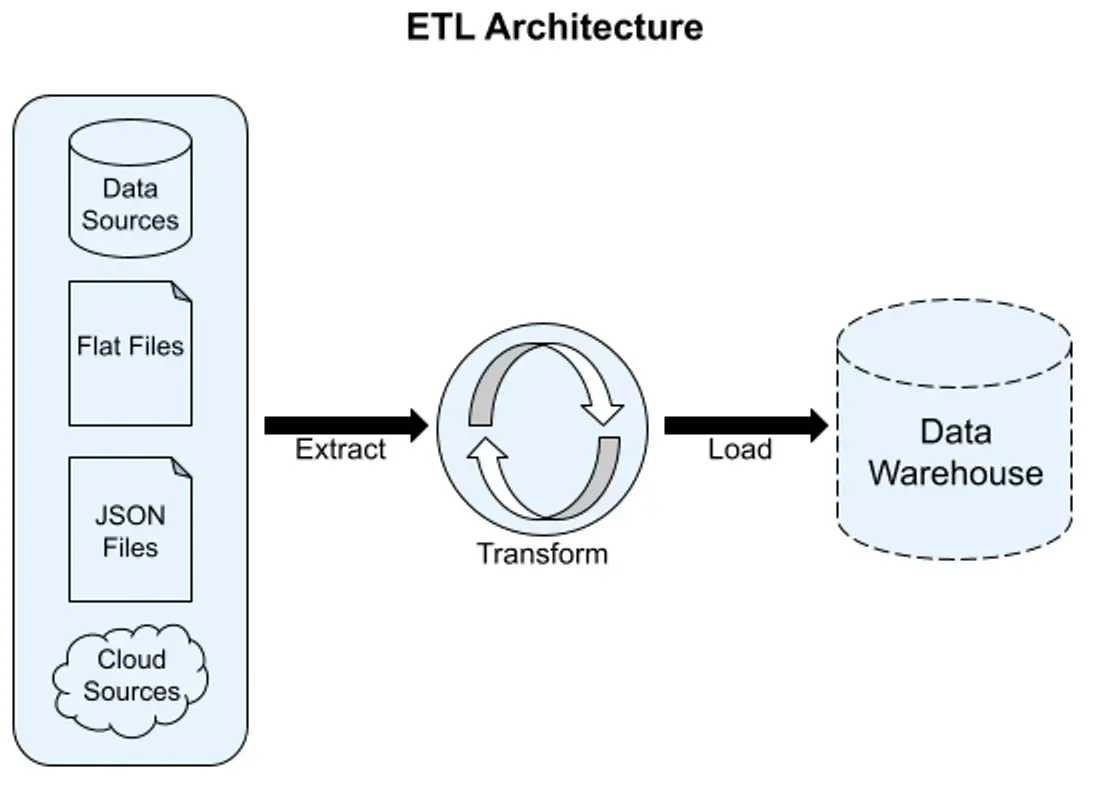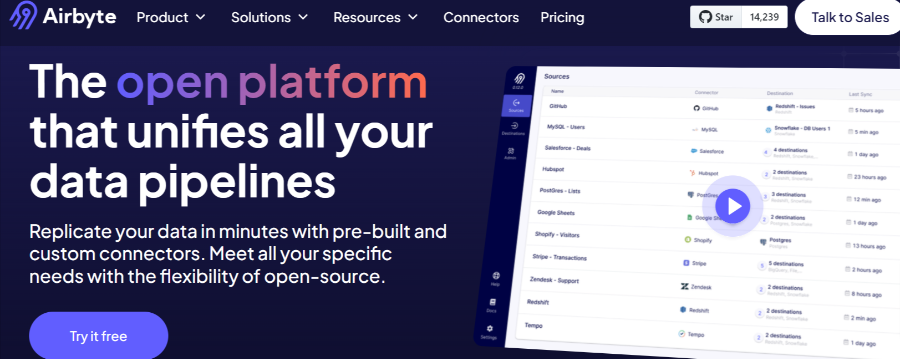ETL Architecture Explained With Diagram [A Data Engineer's Guide]
Summarize this article with:
✨ AI Generated Summary
ETL architecture streamlines data integration by extracting, transforming, and loading data from diverse sources into centralized storage for analysis, enabling better business insights. Key considerations include understanding business needs, data volume, batch vs. streaming processing, and ensuring data quality through cleansing, validation, and monitoring.
- Zero-ETL offers real-time data integration by eliminating intermediate pipelines, reducing latency and costs but requiring advanced monitoring.
- AI-powered automation enhances ETL by generating code, managing data quality dynamically, and optimizing pipeline performance autonomously.
- Tools like Airbyte simplify ETL with no-code connectors, CDC support, and compliance with major data security standards.
Smartphones, tablets, computers, smartwatches, and more generate large amounts of data every day. Analyzing this data can be crucial for your business as it provides insights into your customers' preferences. You can leverage these insights and improve your product development process or marketing campaigns.
The major challenge lies in consolidating data from multiple sources and transforming it into a usable format to extract insights and drive business growth. Having an established ETL process within your organization will save a lot of time and resources. This article provides an overview of the ETL architecture and how it can enhance data management and decision-making.
What Is an ETL Architecture?
ETL stands for Extract, Transform, and Load, a core concept in modern data integration and analytics. It provides a structured approach for moving data from multiple sources, transforming it into a desirable format, and loading it to a destination system for analysis.
Key Components of ETL Architecture
An ETL process involves data passing through different modules. Each module is crucial in ensuring the data is accurately processed from the source to reach the destination.
Data Sources
The initial step in an ETL process is to identify the data sources from which the data needs to be extracted, such as databases, APIs, or sensor data in IoT devices. Data resides in various formats, such as CSV, JSON, or XML.
Landing Area
The landing area is a temporary storage area that stores your extracted data from the sources before you perform any transformations. It may store multiple data batches before moving it through the ETL pipeline.
Staging Area
Data staging is an automated process for efficiently transforming your data. It facilitates the removal of NA or NULL values, saving storage and computing resources. You can also set rules for data cleaning and filtering to eliminate irrelevant or unwanted data. The cleaned data gets enriched and undergoes final validation checks to eliminate any discrepancies.
Destination
The transformed data is stored in the destination or centralized storage system, often a data lake or a data warehouse. This data is then used for analysis using visualization tools or BI tools to gain valuable insights and make informed decisions.
How Does the ETL Process Work in Practice?
A well-defined ETL process enables streamlined data flow without disrupting your existing workflows. Here is a detailed description of the ETL stages:

Transformation
The second process includes converting data into a consistent and accurate format based on your target system compatibility and analytics needs. The data transformation techniques include:
- Data cleaning – identify and manage inaccurate records by removing duplicates, handling missing values, and detecting outliers.
- Data enrichment – enhance existing data by adding additional information (e.g., metadata or external data).
- Data formatting – convert data into a specific format suitable for efficient analysis, storage, and reporting.
- Data filtering – select a subset of data based on specific criteria to focus on relevant information.
- Data validation – ensure that the transformed data meets certain quality standards and is ready for analysis.
Loading
The final stage of the ETL process is loading. It involves loading the transformed data into your destination system, such as a data warehouse, data lake, or business intelligence tool.
Common loading methods:
- Full Loading – transfer all data to the destination system (often used for initial loads).
- Incremental Loading – load only new or updated data to keep up with ongoing updates.
What Key Factors Should You Consider When Designing ETL Architecture?
Understand Your Business Requirements
Clearly identify project objectives and constraints so you can design an ETL architecture that defines data sources, destinations, and transformation requirements, while establishing data quality standards.
Identify the Data Origin and Destination
Knowing where your data originates and where it resides ensures that data is collected, processed, and loaded without inconsistencies.
Data Volume
With exponential growth in data volumes, consider incremental or real-time data processing to gain immediate insights, reduce latency, and optimize costs.
Determine Batch vs. Streaming ETL
- Batch ETL – process data in scheduled batches; ideal for large volumes that are not time-sensitive.
- Streaming ETL – process data as soon as it arrives; ideal for real-time use cases such as stock-market analysis.
How Do Zero-ETL Architectures Transform Data Integration?
Zero-ETL architectures represent a paradigm shift in data integration, eliminating traditional pipeline complexity by enabling direct connections between operational and analytical systems. This approach leverages native cloud integrations and real-time synchronization to move data instantly without intermediate transformation stages.
Understanding Zero-ETL Implementation
Zero-ETL works by embedding transformation logic within destination platforms rather than requiring separate pipeline infrastructure. Cloud data warehouses like Amazon Redshift and Snowflake now support direct querying of operational databases through native integrations, using change data capture to synchronize data continuously. This eliminates the traditional extract and load phases entirely, reducing latency from hours to milliseconds while cutting infrastructure costs significantly.
Strategic Benefits and Considerations
Organizations adopting Zero-ETL report substantial cost reductions through minimized infrastructure and engineering overhead. Financial services companies use this approach for real-time fraud detection, where millisecond response times directly impact business outcomes. However, Zero-ETL introduces new challenges around troubleshooting data inconsistencies without discrete pipeline stages, requiring advanced metadata tracking and monitoring capabilities.
Integration with Modern Data Platforms
Zero-ETL viability depends on cloud-native platforms that support transactional and analytical workloads simultaneously. Technologies like Apache Iceberg enable table formats that unify batch and streaming data, allowing Zero-ETL implementations to handle diverse data types natively. This convergence transforms time-to-insight from days to minutes, though it requires rearchitecting traditional governance models to accommodate direct operational-to-analytical data flows.
What Are the Best Practices for Designing ETL Architecture?
Independent Microservices
Break down your ETL architecture into independent modular stages (extract, transform, load) to enable parallel processing and isolate failures.
Incremental Data Synchronizations
After the initial large extraction, ensure subsequent extractions capture only new or updated data to save computing resources.
Selecting the Right ETL Tool
Consider:
- Connectivity and Integration – pre-built connectors and seamless integration.
- Ease of Use – user-friendly for both technical and non-technical teams.
- Security and Compliance – data encryption, access control, and auditing.
- Cost and Scalability – ability to handle growing data volumes within budget.
- Customer Support – quick, knowledgeable assistance and training resources.
Data Security
Adhere to relevant regulations (e.g., GDPR, HIPAA) by setting policies that safeguard data throughout its lifecycle.
Logging and Monitoring
Practice data observability by logging each ETL subprocess to audit activities and track anomalies.
How Does AI-Powered Automation Enhance ETL Architecture?
Artificial intelligence is revolutionizing ETL processes by automating traditionally manual tasks and optimizing pipeline performance through machine learning. Modern AI-driven ETL systems can generate transformation code, predict and correct data anomalies, and dynamically optimize resource allocation without human intervention.
Generative AI for Pipeline Development
AI-powered platforms now enable natural language pipeline creation, where engineers describe transformations in plain English and the system generates executable code. These tools analyze historical pipeline metadata to recommend optimal transformation logic, reducing manual coding requirements while maintaining high-quality data outputs. Machine learning models can also automatically suggest field mappings and data quality rules based on similar integration patterns, significantly accelerating development cycles.
Automated Data Quality Management
AI-driven ETL tools incorporate machine learning algorithms for dynamic data validation that adapts to changing data patterns. These systems train on historical datasets to predict and correct anomalies during ingestion, such as imputing missing values or flagging currency conversion errors in financial transactions. Rather than using static validation rules, ML models establish data health baselines and automatically trigger alerts when pipeline outputs deviate from expected patterns, shifting quality monitoring from reactive to proactive.
Cognitive Pipeline Optimization
Advanced AI systems now manage holistic pipeline performance through predictive scaling and self-healing capabilities. Reinforcement learning agents monitor throughput, latency, and error rates to dynamically adjust computational resources during traffic spikes while maintaining service level agreements. These autonomous systems can reduce pipeline downtime significantly and optimize cloud resource utilization for substantial cost savings at enterprise scale, creating self-managing data fabrics that require minimal human intervention beyond high-level policy definition.
How Can Airbyte Simplify Your ETL Implementation?
Airbyte is a no-code platform that simplifies data integration. With over 350 pre-built connectors, it extracts data from sources like DynamoDB, Firebolt, and Asana, integrates with dbt for transformations, and loads data into destinations such as S3, BigQuery, and Redshift.
If a required connector is missing, you can build one in about 30 minutes with the Connector Development Kit.

Unique Features of Airbyte
- Multiple interfaces: UI, API, Terraform Provider, and PyAirbyte.
- Support for Change Data Capture (CDC) to minimize redundancy and resource use.
- Compliance with HIPAA, ISO, SOC 2, and GDPR to ensure data security.
For more details, see the official documentation.
Conclusion
The ETL architecture plays a crucial role in transforming raw data from diverse sources into a clean, analyzable format. By understanding its components, key design factors, and best practices—and by leveraging robust tools—you can establish a reliable ETL pipeline that unlocks valuable insights for data-driven decisions.
FAQs
What is an ETL architecture?
ETL architecture provides a structured approach for moving data from multiple sources, transforming it into a desirable format, and loading it to a destination system for analysis.
How do you ensure data quality in ETL processes?
Ensuring data quality involves data cleansing, validation, auditing, and logging to analyze source data for inconsistencies and check them against predefined rules.

.webp)
![ETL Architecture Explained With Diagram [A Data Engineer's Guide]](https://cdn.prod.website-files.com/687b2d16145b3601a227c560/68d2b5e838966b3be1c7d907_68ce86f7e7e7b420ce3ee66b_667cfe6193203d9b1a743c71_ETL%252520Architecture.png)